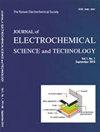交联聚乙烯醇(PVA)和壳聚糖(CS)离子交换膜在微生物燃料电池中的生物发电
IF 3
4区 工程技术
Q3 ELECTROCHEMISTRY
Journal of electrochemical science and technology
Pub Date : 2023-08-25
DOI:10.33961/jecst.2023.00395
引用次数: 0
摘要
微生物燃料电池(MFCs)是一种生物电化学系统,其中电化学活性细菌将有机废物转化为电能。聚乙烯醇(PVA)和壳聚糖(CS)是许多电化学系统中潜在的离子交换膜替代品。研究了PVA和壳聚糖CS在MFC用PVA:CS复合膜中的最佳配比。合成了1:1、2:1和3:1比例的PVA:CS复合膜并进行了测试。通过对PVA:CS膜的吸水性和离子交换能力、傅里叶变换红外光谱和扫描电镜图像的分析,确定了PVA:CS膜的物理化学性质。将制备的膜应用于MFC系统的离子交换膜上,考察其对电化学性能的影响。结果表明,PVA:CS比为3:1的复合膜的性能与商品化的Nafion膜相当,并且比其他合成膜产生更多的电。采用mfc的PVA:CS膜的最大功率密度为0.026 mW cm -2,性能稳定。因此,它可以应用于一个经济高效的MFC系统。本文章由计算机程序翻译,如有差异,请以英文原文为准。
Bioelectricity Generation Using a Crosslinked Poly(vinyl alcohol) (PVA) and Chitosan (CS) Ion Exchange Membrane in Microbial Fuel Cell
Microbial fuel cells (MFCs) are a bioelectrochemical system where electrochemically active bacteria convert organic waste into electricity. Poly(vinyl alcohol) (PVA) and chitosan (CS) are polymers that have been studied as potential alternative ion exchange membranes to Nafion for many electrochemical systems. This study examined the optimal mixing ratio of PVA and chitosan CS in a PVA:CS composite membrane for MFC applications. PVA:CS composite membranes with 1:1, 2:1, and 3:1 ratios were synthesized and tested. The water uptake and ion exchange capacity, Fourier transform infrared spectra, and scanning electron microscopy images were analyzed to determine the physicochemical properties of PVA:CS membranes. The prepared membranes were applied to the ion exchange membrane of the MFC system, and their effects on the electrochemical performance were evaluated. These results showed that the composite membrane with a 3:1 (PVA:CS) ratio showed comparable performance to the commercialized Nafion membrane and produced more electricity than the other synthesized membranes. The PVA:CS membrane implemented MFCs produced a maximum power density of 0.026 mW cm –2 from organic waste with stable performance. Therefore, it can be applied to a cost-effective MFC system.
求助全文
通过发布文献求助,成功后即可免费获取论文全文。
去求助
来源期刊

Journal of electrochemical science and technology
ELECTROCHEMISTRY-
CiteScore
6.30
自引率
8.10%
发文量
44
期刊介绍:
Covering fields:
- Batteries and Energy Storage
- Biological Electrochemistry
- Corrosion Science and Technology
- Electroanalytical Chemistry and Sensor Technology
- Electrocatalysis
- Electrochemical Capacitors & Supercapcitors
- Electrochemical Engineering
- Electrodeposition and Surface Treatment
- Environmental Science and Technology
- Fuel Cells
- Material Electrochemistry
- Molecular Electrochemistry and Organic Electrochemistry
- Physical Electrochemistry
- Solar Energy Conversion and Photoelectrochemistry
 求助内容:
求助内容: 应助结果提醒方式:
应助结果提醒方式:


